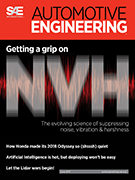Magazine

Aerospace & Defense Technology: August 2020
2020-08-01
Reverse Engineering the Boeing E-3 Sentry's Secondary Flight Controls Vanadium - A Green Metal Critical to Aerospace and Clean Energy Thrust in Space - The Nuances of Thruster Valve Design 3D Printing Aerodynamic Improvements Cryogenic-Capable Isolators Improve the Performance of Millimeter-Wave Systems by Lowering Noise Levels Detection with Quantum Radar A new radar prototype utilizes quantum entanglement as a method of object detection. Preliminary Development of an Integrated Mobility, Lethality, and Survivability Soldier Performance Testing Platform Developing a methodology that incorporates objective measures of performance and is sensitive to changes in soldier-system equipment could help guide equipment manufacturers during product development and acquisition. Bore Elevation and Azimuth Measurement System (Beams) Newly developed laser apparatus verifies that the pointing accuracy requirement of a weapon's fire control system is met.



















